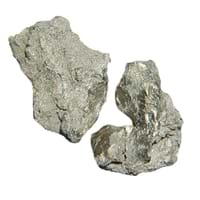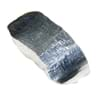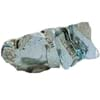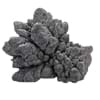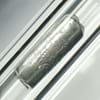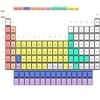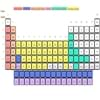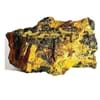Indium vs Zirconium
Periodic Table
Symbol
In
Zr
Group Number
13
5
4
14
Period Number
5
5
Block
p block
d block
Element Family
Post-Transition
Transition Metal
CAS Number
7440746
17
7440677
23
Space Group Name
I4/mmm
P63/mmc
Space Group Number
139.00
8
194.00
5
Facts
Interesting Facts
- Luster of Indium is bright in nature.
- Reich and richer were looking for thallium in zinc metal and they discovered Indium metal.
- Zirconium metal can resist to weak acids.
- Zirconium metal reacts with oxygen and nitrogen in the atmosphere.
Sources
Mining, Ores of metals
Found in Minerals, Mining, Ores of Minerals
History
Who Discovered
Ferdinand Reich and Hieronymous Theodor Richter
Martin Heinrich Klaproth
Discovery
In 1863
In 1789
Abundance
Abundance In Universe
3 * 10-8 %
28
5 * 10-6 %
13
Abundance In Sun
~0.0000004 %
23
~0.000004 %
16
Abundance In Meteorites
0.00 %
99+
0.00 %
17
Abundance In Earth's Crust
0.00 %
99+
0.01 %
14
Abundance In Oceans
0.00 %
99+
0.00 %
23
Abundance In Humans
Not Available
0.00 %
15
Uses
Uses & Benefits
- It is used to produce indium tin oxide (ITO), it is used in manufacturing touch screens, flat screen TVs and solar panels.
- Its nitride, phosphide and antimonide are used in transistors and microchips.
- As this metal does not absorb neutrons; It is used in nuclear power stations.
- Its oxide is used in ultra strong ceramics. It is also used in manufacturing Crucibles.
Industrial Uses
Aerospace Industry, Automobile Industry
Aerospace Industry, Ammunition Industry
Medical Uses
Medical Research
NA
Other Uses
Alloys, In Nuclear Reactors
Alloys, Nuclear Research, Research Purposes
Biological Properties
Toxicity
Non Toxic
NA
Present in Human Body
Yes
Yes
In Blood
Not Available
0.01 Blood/mg dm-3
21
In Bone
Not Available
0.10 p.p.m.
23
Physical Properties
Melting Point
156.61 °C
99+
1,852.00 °C
15
Boiling Point
2,000.00 °C
99+
4,377.00 °C
11
Appearance
Physical State
Solid
Solid
Color
Silvery Gray
Silvery White
Luster
Lustrous
Lustrous
Hardness
Mohs Hardness
1.20
20
5.00
8
Brinell Hardness
8.80 MPa
99+
638.00 MPa
19
Vickers Hardness
Not Available
820.00 MPa
15
Speed of Sound
1,215.00 m/s
99+
3,800.00 m/s
20
Optical Properties
Allotropes
No
No
α Allotropes
Not Available
Not Available
β Allotropes
Not Available
Not Available
γ Allotropes
Not Available
Not Available
Chemical Properties
Chemical Formula
In
Zr
Isotopes
Known Isotopes
35
4
24
15
Electronegativity
Pauling Electronegativity
1.78
16
1.33
30
Sanderson Electronegativity
2.14
8
0.90
25
Allred Rochow Electronegativity
1.49
13
1.22
26
Mulliken-Jaffe Electronegativity
1.76
10
Not Available
Allen Electronegativity
1.66
18
1.32
34
Electropositivity
Pauling Electropositivity
2.22
38
2.67
24
Ionization Energies
1st Energy Level
558.30 kJ/mol
99+
640.10 kJ/mol
99+
2nd Energy Level
1,820.70 kJ/mol
18
1,270.00 kJ/mol
99+
3rd Energy Level
2,704.00 kJ/mol
39
2,218.00 kJ/mol
99+
4th Energy Level
5,210.00 kJ/mol
17
3,313.00 kJ/mol
99+
5th Energy Level
Not Available
7,752.00 kJ/mol
10
6th Energy Level
Not Available
9,500.00 kJ/mol
15
Electrochemical Equivalent
1.43 g/amp-hr
99+
0.85 g/amp-hr
99+
Electron Work Function
4.12 eV
24
4.05 eV
26
Other Chemical Properties
Ionization, Radioactive Isotopes, Radioactivity, Solubility
Anti Corrosion, Flammable, Ionization, Radioactive Isotopes, Solubility
Atomic Properties
Atomic Number
49
99+
40
99+
Electron Configuration
[Kr] 4d10 5s2 5p1
[Kr] 4d2 5s2
Crystal Structure
Tetragonal (TETR)
Hexagonal Close Packed (HCP)
Crystal Lattice
TETR-Crystal-Structure-of-Indium.jpg#100
HCP-Crystal-Structure-of-Zirconium.jpg#100
Atom
Number of Protons
49
99+
40
99+
Number of Neutrons
66
99+
51
99+
Number of Electrons
49
99+
40
99+
Radius of an Atom
Atomic Radius
167.00 pm
24
160.00 pm
27
Covalent Radius
142.00 pm
99+
175.00 pm
23
Van der Waals Radius
193.00 pm
31
200.00 pm
28
Atomic Weight
114.82 amu
99+
91.22 amu
99+
Atomic Volume
15.70 cm3/mol
33
14.10 cm3/mol
36
Adjacent Atomic Numbers
Valence Electron Potential
54.00 (-eV)
25
80.00 (-eV)
18
Lattice Constant
325.23 pm
99+
323.20 pm
99+
Lattice Angles
π/2, π/2, π/2
π/2, π/2, 2 π/3
Lattice C/A Ratio
Not Available
1.59
8
Mechanical Properties
Density
Density At Room Temperature
7.31 g/cm3
99+
6.52 g/cm3
99+
Density When Liquid (at m.p.)
7.02 g/cm3
33
5.80 g/cm3
99+
Tensile Strength
2.50 MPa
21
330.00 MPa
12
Viscosity
Not Available
Not Available
Vapor Pressure
Vapor Pressure at 1000 K
0.01 (Pa)
11
Not Available
Vapor Pressure at 2000 K
Not Available
0.00 (Pa)
21
Elasticity properties
Shear Modulus
Not Available
33.00 GPa
20
Bulk Modulus
Not Available
91.10 GPa
17
Young's Modulus
11.00 GPa
99+
88.00 GPa
22
Poisson Ratio
Not Available
0.34
10
Other Mechanical Properties
Ductile, Malleable
Ductile, Malleable
Magnetic Properties
Magnetic Characteristics
Specific Gravity
7.31
99+
6.51
99+
Magnetic Ordering
Diamagnetic
Paramagnetic
Electrical Properties
Electrical Property
Conductor
Conductor
Resistivity
83.70 nΩ·m
34
421.00 nΩ·m
11
Electrical Conductivity
0.12 106/cm Ω
17
0.02 106/cm Ω
99+
Electron Affinity
28.90 kJ/mol
31
41.10 kJ/mol
27
Thermal Properties
Specific Heat
0.23 J/(kg K)
27
0.27 J/(kg K)
19
Molar Heat Capacity
26.74 J/mol·K
25
25.36 J/mol·K
99+
Thermal Conductivity
81.80 W/m·K
21
22.60 W/m·K
99+
Critical Temperature
Not Available
Not Available
Thermal Expansion
32.10 µm/(m·K)
9
5.70 µm/(m·K)
99+
Enthalpy
Enthalpy of Vaporization
226.40 kJ/mol
40
581.60 kJ/mol
9
Enthalpy of Fusion
3.28 kJ/mol
99+
20.90 kJ/mol
11
Enthalpy of Atomization
242.70 kJ/mol
99+
598.00 kJ/mol
10
Standard Molar Entropy
57.80 J/mol.K
22
39.00 J/mol.K
39
|
||
|
||
|

